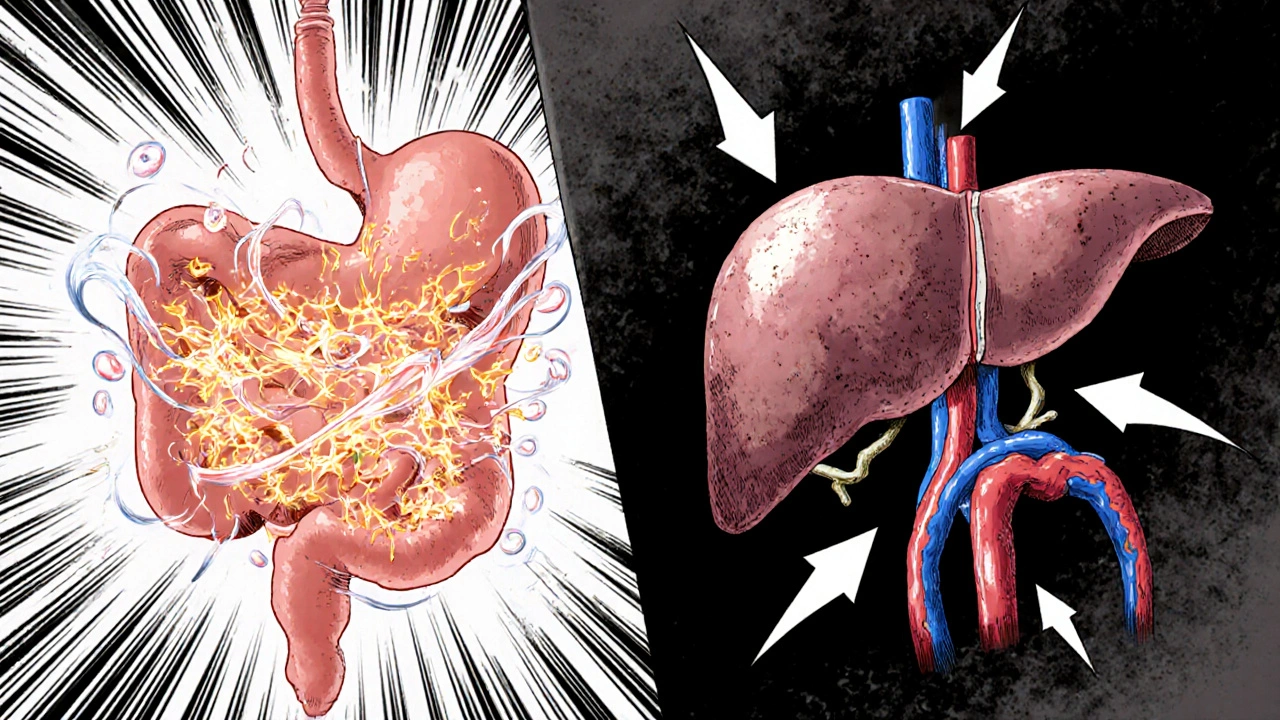Understanding the Benefits of Sitagliptin‑Metformin for Diabetes Management
 Oct, 17 2025
Oct, 17 2025
HbA1c Reduction Calculator
Calculate expected HbA1c reduction when adding sitagliptin to your metformin treatment.
Your results will appear here after calculation
When treating Type 2 Diabetes is a chronic condition characterized by insulin resistance and progressive beta‑cell decline. Managing it well means keeping blood sugar steady while avoiding weight gain and low blood sugar episodes. That’s where Sitagliptin‑metformin is a fixed‑dose combination of a DPP‑4 inhibitor (sitagliptin) and a biguanide (metformin) comes into play.
How the combo works
Both ingredients hit different metabolic pathways, so they complement each other.
- Sitagliptin is a DPP‑4 inhibitor that blocks the enzyme dipeptidyl peptidase‑4, prolonging the action of incretin hormones (GLP‑1 and GIP). This boosts insulin release after meals and suppresses glucagon, lowering post‑prandial glucose.
- Metformin belongs to the biguanide class. It primarily reduces hepatic glucose production and improves peripheral insulin sensitivity, which keeps fasting glucose in check.
Because one drug targets fasting glucose and the other targets post‑meal spikes, the pair delivers a more balanced glycemic profile than either agent alone.
Clinical benefits
The sitagliptin metformin combination has been studied in several large trials involving thousands of patients. Here’s what the data consistently show:
Improved HbA1c reduction
When added to diet and exercise, the combo lowers HbA1c by an average of 1.3‑1.5 percentage points, which is roughly 0.3‑0.4% more than metformin alone.
Weight neutrality
Metformin’s modest weight‑loss effect offsets the slight weight gain sometimes seen with sitagliptin. Most patients stay within ±1kg of baseline, a clear advantage over sulfonylureas that often add several kilograms.
Low hypoglycemia risk
Neither component stimulates insulin when glucose is low, so the risk of dangerous drops in blood sugar is minimal. In head‑to‑head studies, hypoglycemia rates were below 2% for the combo, compared with 5‑7% for insulin‑based regimens.
Cardiovascular and renal signals
Large outcome trials for sitagliptin (e.g., the TECOS study) and metformin individually have shown neutral to modestly positive effects on heart health. When combined, the drugs do not increase major adverse cardiovascular events and may slow the progression of diabetic kidney disease by reducing albuminuria.
Who should consider sitagliptin‑metformin?
The combo is ideal for patients who:
- Need stronger glucose control than metformin alone can provide.
- Prefer an oral regimen over injectable GLP‑1 agonists or insulin.
- Are concerned about weight gain.
- Have a low risk of severe renal impairment (eGFR≥30mL/min/1.73m²).
It’s less suitable for those with a history of pancreatitis, severe liver disease, or lactic acidosis risk.

Practical considerations
Typical starting doses are 50mg sitagliptin+500mg metformin taken once daily with the morning meal. The dose can be titrated up to 100mg/1000mg twice daily based on tolerance and glycemic response.
Common side effects include mild gastrointestinal upset (mostly from metformin) and occasional nasopharyngitis (from sitagliptin). Most patients adapt within 2‑3weeks.
Key contraindications:
- eGFR<30mL/min/1.73m².
- History of severe hypersensitivity to either component.
- Pregnancy and breastfeeding - safer alternatives are recommended.
Drug interactions are limited, but caution is advised with CYP3A4 inhibitors (e.g., ketoconazole) that can raise sitagliptin levels.
Comparison with other regimens
| Regimen | HbA1c Reduction | Weight Change | Hypoglycemia Risk | Cardiovascular Impact |
|---|---|---|---|---|
| Sitagliptin‑metformin | ‑1.4% (average) | ±1kg | Low (~2%) | Neutral‑to‑positive |
| Metformin alone | ‑1.0% | ‑1kg | Low | Positive |
| Sitagliptin alone | ‑0.8% | ±0kg | Low | Neutral |
| Sulfonylurea + metformin | ‑1.5% | +2‑3kg | Moderate‑high | Neutral |
| Insulin therapy | ‑2.0% or more | Variable (often gain) | High | Neutral |
The table shows that sitagliptin‑metformin delivers a sweet spot: solid HbA1c drops without the weight gain or hypoglycemia seen with sulfonylureas or insulin.

Frequently asked questions
Frequently Asked Questions
Can I take sitagliptin‑metformin if I have mild kidney disease?
Yes, as long as your eGFR is 30mL/min/1.73m² or higher. The dose may need to be reduced, and your doctor should monitor kidney function every few months.
Does the combo cause stomach upset?
Metformin is the usual culprit. Taking the tablet with a full‑size meal and starting at a low dose can help the stomach adjust.
Do I need to monitor blood sugar less often?
You’ll still need regular checks, especially during dose changes. Many patients find that fasting glucose stabilizes, so they can switch to twice‑weekly checks after a few months of steady control.
Is this combo safe during pregnancy?
Both sitagliptin and metformin fall into pregnancy‑category C. Doctors usually prefer insulin or lifestyle‑only measures for pregnant women.
How does the combo compare cost‑wise to separate pills?
One tablet usually costs a bit more than a generic metformin pill but less than buying two brand‑name drugs separately. Insurance plans often cover the combo as a single prescription.
Key takeaways
- The sitagliptin‑metformin fixed‑dose combo blends two complementary mechanisms to lower both fasting and post‑meal glucose.
- It delivers a reliable 1.3‑1.5% HbA1c drop while keeping weight stable and hypoglycemia rare.
- Patients with mild‑to‑moderate kidney function and no history of pancreatitis are prime candidates.
- Side effects are mostly mild gastrointestinal issues; starting low and taking with food helps.
- Compared with sulfonylureas or insulin, the combo offers a better safety profile without sacrificing efficacy.

Lauren Sproule
October 17, 2025 AT 14:23Great summary love the clear breakdown
CHIRAG AGARWAL
October 22, 2025 AT 05:30LOL this combo sounds like a marketing gimmick
Michael Dalrymple
October 26, 2025 AT 19:37The pharmacological rationale behind pairing sitagliptin with metformin merits close scrutiny. By targeting both post‑prandial glucose excursions and basal hepatic output, the combination theoretically offers a more comprehensive glycaemic control than monotherapy. Clinical trials have consistently documented an HbA1c reduction in the range of 1.3 to 1.5 percentage points when the duo is added to lifestyle measures. This magnitude of decline is modestly superior to metformin alone, suggesting an additive effect rather than mere coincidence. Moreover, the weight profile remains largely neutral, as metformin’s modest weight‑loss influence offsets the slight weight gain occasionally attributed to sitagliptin. Such neutrality is advantageous compared with sulfonylureas, which are notorious for inducing weight gain. The risk of hypoglycaemia is also minimal, given that neither agent stimulates insulin secretion in the absence of hyperglycaemia. Safety data indicate hypoglycaemia rates below two percent, a figure that pales against insulin‑based regimens. Cardiovascular outcomes from the TECOS trial and the broader metformin literature reveal at least neutrality, and perhaps a modest benefit, on major adverse cardiac events. Renal outcomes are similarly reassuring, with reductions in albuminuria observed in some subgroup analyses. Patient adherence may improve owing to the convenience of a fixed‑dose tablet, reducing pill burden and simplifying dosing schedules. Nevertheless, clinicians must remain vigilant regarding contraindications such as significant renal impairment (eGFR < 30 mL/min/1.73 m²) and a history of pancreatitis. Dose titration should commence with 50 mg/500 mg once daily, advancing cautiously based on tolerability. Gastrointestinal upset, primarily from the metformin component, typically resolves within two to three weeks. In practice, the sitagliptin‑metformin combination represents a viable option for individuals requiring intensified oral therapy without resorting to injectables.
Emily (Emma) Majerus
October 31, 2025 AT 10:43Sounds solid thanks for the depth
Virginia Dominguez Gonzales
November 5, 2025 AT 01:50Wow, reading this feels like watching a well‑orchestrated symphony of metabolic pathways! The way sitagliptin and metformin dance together-one handling the spikes after meals, the other keeping the overnight glucose in check-is nothing short of poetic. It’s especially reassuring to see the weight neutrality highlighted; nobody wants to trade sugar control for an extra few pounds. And the low hypoglycemia risk? That’s a huge win for patients who dread those scary drops. The cardiovascular and renal hints of benefit add an extra layer of confidence, painting this combo as more than just glucose‑lowering. All in all, it’s a compelling case for a pill that truly balances efficacy and safety.
Carissa Padilha
November 9, 2025 AT 16:57Sure, the data look clean on the surface, but have you ever wondered who’s really funding these "large outcome trials"? Every time a new combo gets a shiny label, the pharma giants roll out a wave of press releases and conference talks. It’s easy to miss the subtle shifts in study design that favor their product-like choosing comparator arms that are deliberately under‑dosed. And let’s not forget the hidden clauses in patient consent forms; many participants aren’t fully aware that their data might be repurposed for marketing. The renal benefits, for instance, could simply be a side‑effect of better glycaemic control, not a direct drug action. In the end, while the combo sounds promising, we should keep a skeptical eye on the narratives being pushed. The truth often hides in the fine print, not the glossy abstracts. Stay vigilant.
Richard O'Callaghan
November 14, 2025 AT 08:03I think the gi upset is ovrated but who knw the pharma push
Alexis Howard
November 18, 2025 AT 23:10Not convinced its worth it
RJ Samuel
November 23, 2025 AT 14:17So you’re telling me we finally have a pill that actually respects our daily grind? I love the colorful metaphor of a "dance"-makes the science feel less like a lecture and more like a story. Still, I’m a bit wary of getting too excited; the long‑term real‑world data will tell us if this is a fleeting fad or a genuine step forward. Either way, it’s a refreshing change from the usual insulin‑centric chatter.
Nickolas Mark Ewald
November 28, 2025 AT 05:23Appreciate the balanced view. This combo could help many patients stay on oral therapy longer.
Chris Beck
December 2, 2025 AT 20:30This drug is just another us pharma ploy, nothing more, nothing less.
Winston Bar
December 7, 2025 AT 11:37Whatever the studies say, they hide the real numbers. Look beyond the press releases.
Miriam Rahel
December 12, 2025 AT 02:43While the exposition is thorough, the author neglects to cite recent meta‑analyses that question the incremental benefit of sitagliptin when added to metformin, especially in patients with modest baseline HbA1c. Moreover, the discussion of cardiovascular outcomes lacks nuance, failing to differentiate between neutral and potentially beneficial effects. A more rigorous appraisal of the safety profile, particularly regarding pancreatitis risk, would enhance the credibility of the piece.